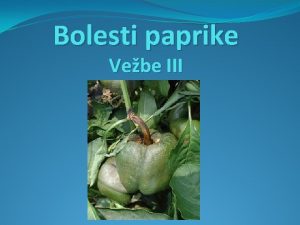Castanea spp responses to Phytophthora cinnamomi towards new

- Slides: 1

Castanea spp. responses to Phytophthora cinnamomi: towards new approaches to unravel the host-pathogen Patrícia Fernandes , Carmen Santos Helena Machado , Pedro Fevereiro , Maria do Céu Silva , Rita Lourenço Costa system Ph. D in Biology 1, 3, 5 1, 3 1 3, 4, * 5, 6, * 1, 2, * 1 Instituto de Investigação Agrária e Veterinária, I. P. ; 2 Centro de Estudos Florestais, Instituto Superior de Agronomia, Universidade de Lisboa; 3 Instituto de Tecnologia Química e Biológica, Universidade Nova de Lisboa; 4 Departamento de Biologia Vegetal , Faculdade de Ciências da Universidade de Lisboa; 5 Centro de Investigação das Ferrugens do Cafeeiro, Instituto Superior de Agronomia, Universidade de Lisboa; 6 Linking Landscape, Environment, Agriculture and Food, Instituto Superior de Agronomia, Universidade de Lisboa; * Supervisors. INTRODUCTION The European chestnut (Castanea sativa) is a multipurpose species of great economic importance in Europe. However it is threatened by the pathogen Phytophthora cinnamomi that causes severe root rot, also known as ink disease. The Asian species, Japanese (Castanea crenata) and Chinese chestnuts (Castanea mollissima), show resistance to this pathogen. Chestnut showing ink disease symptoms and lesions on the root after death [1] APPROACHESTNUT BREEDING PROGRAM The program, initiated in 2006, has been based on the introgression of resistance genes from the Asian species into the European chestnut, through controlled crosses. Hybrid segregating progenies obtained were phenotyped, through the inoculation with the pathogen[1]. Four hybrids showing different levels of resistance to P. cinnamomi, together with the two contrasting phenotypes regarding disease resistance (C. sativa and C. crenata), were selected to understand the cellular and molecular modifications induced by the pathogen. This breeding program already produced a body of knowledge contributions through different papers [1][2][3][4]. Susceptible Resistant X C. crenata PHENOTYPING Resistant X C. sativa C. mollissima LEVEL OF RESISTANCE [1][3] HYBRID POPULATIONS HOW CAN WE UNDERSTAND THE DIFFERENT RESPONSES REVEALED BY SUSCEPTIBLE AND RESISTANT GENOTYPES? 1 HISTOPATHOLOGY Characterization of the host-pathogen system: Six months-old plants will be inoculated with P. cinnamomi. At different times after inoculation, root samples (inoculated and control) will be collected and prepared for light microscopic observations. The progression of pathogen infection and the sequence of responses it induces in root tissues of resistant and susceptible genotypes will be evaluated. P. cinnamomi zoospores (arrows) encystment and penetration The results will be used to choose the adequate time-points after inoculation to collect root samples for RNA-seq analysis 2 TRANSCRIPTOME ANALYSIS c. DNA libraries will be synthetized from total RNA from the parents of the crosses (C. sativa and C. crenata), and also from four progenies with different phenotypes to P. cinnamomi infection. The root transcriptome profiles, of the resistant and susceptible genotypes, will be compared, before and after inoculation. Results will be compared with the previous ones obtained by the team[3][4]. The sequencing will be performed by using the Illumina platform Identification of candidate genes linked with the resistance of P. cinnamomi 3 VALIDATION OF THE CANDIDATE GENES Quantitative digital PCR; Microscopy techniques; Functional validation with optimized transformation protocols, available for chestnut species and Arabidopsis thaliana. REFERENCES: [1] Santos et al. (2015) Plant Pathology 64: 901– 910. doi: 10. 1111/ppa. 12313. [2] Santos et al. (2015) Scientia Horticulturae 194: 181– 187. http: //dx. doi. org/10. 1016/j. scienta. 2015. 07. 043. [3] Santos et al. (2017) Frontiers in Plant Science. 8: 515. doi: 10. 3389/fpls. 2017. 00515. [4] Serrazina et al. (2015) Tree Genetics & Genomes. 11: 6. doi: 10. 1007/s 11295 -014 -0829 -7. ACKNOWLEDGMENTS: This work will be funded by Portuguese national funds through Fundação para a Ciência e a Tecnologia. (grant SFRH/BD/115424/2016)

